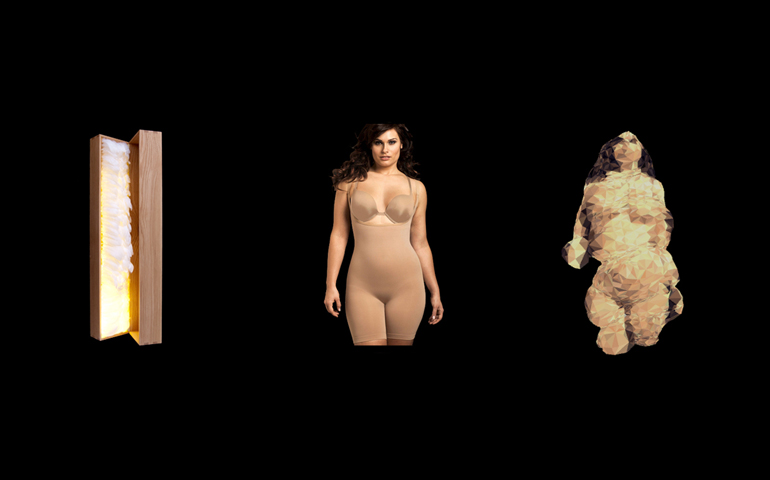
What does a simple wooden box and a woman wearing a body wrap have in common? Only Google, a ‘Hill Climbing Algorithm’ and Shapeways 3D Printer can show us. Venus of Google is an experimental work by artist Matthew Plummer-Fernandez exploring emerging technology and culture.

The Venus of Google was ‘found’ via a Google search-by-image, googling a photograph taken of an object I had been handed over in a game of exquisite corpse. The Google search returned visually similar results, one of these being an image of a woman modeling a body-wrap garment. I then used a similar algorithmic image-comparison technique to drive the automated design of a 3D printable object. The ‘Hill-Climbing’ algorithm starts with a plain box shape and tries thousands of random transformations and comparisons between the shape and the image, eventually mutating towards a form resembling the found image in both shape and colour. I’m interested in this early era of artificial intelligence, computer vision and algorithmic artefacts, exemplifying the paradox of technology being both advanced and primitive at the same time. The Long Tail Multiplier series investigates the potential use of algorithms to create virtually infinite cultural artefacts, inspired by the stories of these algorithmic books and t-shirts.
The Long Tail Multiplier system is based on a Hill Climbing Algorithm. The 3D Mesh render and distortion is done with Processing and the Hemesh library. The image comparison is managed with a Python script calling a command-line tool called ImageMagick.
The object was 3D printed in full color by Shapeways.
Matthew Plummer-Fernandez is an artist exploring emerging technology and culture. He uses scanning, digital fabrication and computational approaches to making artefacts, both physical and digital, that blur the distinction between the two, referencing the digitisation of the everyday. Plummer-Fernandez received his MA from the Royal College of Art in 2009, after studies in Graphic Design and a BEng in Computer-Aided Mechanical Engineering at Kings College London. His work has been exhibited and published globally including relevant articles on Creative Applications, Rhizome, and Creators Project, and has received commissions from curators Arts Co, It’s Nice That, and Selfridges. He is currently based in South East London, working in research at Goldsmiths College.



thats pretty cool! the venus of google!
especially the exploration of what we could call early artifical intelligence!
Hadnt really thought of it that way
Yes! Finally something about hamster for sale.
Right here is the right site for everyone who hopes to understand this topic.
You understand a whole lot its almost tough to argue with you (not that
I personally would want to…HaHa). You certainly put a brand new spin on a subject that’s been discussed for decades. Wonderful stuff, just excellent!
Hello! I could have sworn I’ve been to your blog before but after looking at a few of the posts I realized it’s new to me.
Nonetheless, I’m definitely delighted I stumbled upon it and I’ll be bookmarking
it and checking back often!
You Green Coffee people seem to just love 3D Printing. And Spam sandwiches, no doubt!
“audio quality for audio songs present at this site ” —- Ahahahaha, you spammers are just too much!
Nice job, it’s a great post. The details is good to find out!